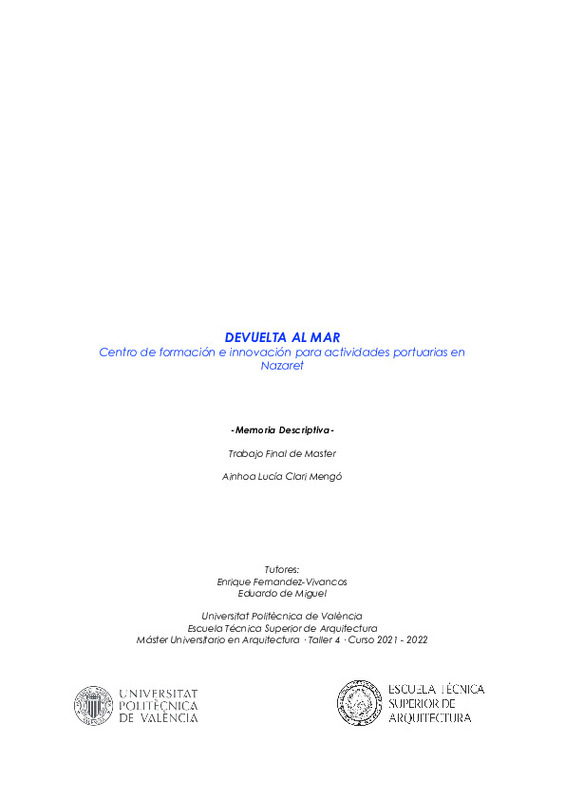|
Resumen:
|
[ES] El barrio de Nazaret ha tenido durante muchos años un vínculo muy significativo con el mar y las actividades relacionadas con este, como la pesca o actividades recreativas. Sin embargo, con el avance del puerto a lo ...[+]
[ES] El barrio de Nazaret ha tenido durante muchos años un vínculo muy significativo con el mar y las actividades relacionadas con este, como la pesca o actividades recreativas. Sin embargo, con el avance del puerto a lo largo de los años Nazaret perdió su mar y con ello parte de su identidad.
Se plantea, por tanto, encontrar un punto en común con el puerto, que pueda abrir Nazaret de nuevo al mar, mejorar la relación de sus habitantes con el puerto y ofrecer a su vez a los vecinos del barrio nuevas oportunidades de formación y trabajo que tengan una visión de futuro en relación con la innovación en actividades portuarias, como el transporte marítimo tanto recreativo como comercial.
Para ello se propone actuar sobre los antiguos astilleros de la Unión Naval del Levante, que se encuentran en el límite entre Nazaret y el puerto. Se trata de un conjunto industrial compuesto de varias naves cuya construcción se inició en 1918 y que ha sufrido diversos cambios a lo largo de los años. Inicialmente construido como astilleros para la construcción de embarcaciones de carga y pasaje llegó también a fabricar, durante de la Guerra Civil, vehículos blindados y armamento de guerra, hasta más tarde acabar con la reparación de buques y finalmente el cese de su actividad en 2012.
La evolución del conjunto a través del tiempo y su cambio de uso advierte de las posibilidades de adaptación de dichas naves industriales y es por eso por lo que suponen el emplazamiento perfecto para un centro formativo que pretende ser un espacio en miras al futuro para el sector portuario y que apueste por la generación de un puerto más sostenible.
El centro formativo se situará en las dos naves del conjunto que fueron construidas en 1940 tras la guerra civil y que se encuentran cruzando el rio y mirando desde el puerto hacia Nazaret. La relación entre las naves y el barrio se produce a través de la continuación del parque lineal del río y con finalmente con su desembocadura en el mar. A nivel programático en el centro se desarrollarán actividades, enfocadas sobre todo hacia el desarrollo productivo que deberán poder evolucionar con
el tiempo según cambien las necesidades de la población. Se entenderá también como un espacio de creación e innovación que fomentará el emprendimiento de los alumnos y las relaciones con empresas del sector.
[-]
[EN] The neighbourhood of Nazaret has had for many years a very significant relationship with the sea and the activities related to it, like fishing or recreational activities. However, with the advance of the harbour over ...[+]
[EN] The neighbourhood of Nazaret has had for many years a very significant relationship with the sea and the activities related to it, like fishing or recreational activities. However, with the advance of the harbour over the years, Nazaret has lost its sea and with it part of its identity.
On this basis, it is proposed to find a common ground with the harbour, which allows Nazaret to be opened to the sea again, improves the relationship of its inhabitants with the harbour and offers at the same time new opportunities for education and labour with a foresight approach to innovation in port activity such as maritime transport both recreational and commercial.
For this end, it is proposed to act on the former shipyards of the Naval Union of Levante (UNL) which is situated on the border between Nazaret and the harbour. It is an industrial complex composed of several warehouses, the construction of which started in 1918 and has suffered multiple changes throughout the years. Initially built as a shipyard for boat construction it has also served, during the Spanish Civil War, as a factory for armoured vehicles and armament, and onward as a vessel repair factory and finally in 2012 its standstill.
The evolution of the complex through time and its change in use evidences the possibilities of adaptation of the buildings and that is why it is the perfect spot for an education centre which seeks to be a future-oriented teaching space for the port sector, and which opts for the generation of a more sustainable harbour.
The education centre will be situated in the two warehouses which were built in 1940 after the civil war and which are located crossing the river and looking from the harbour towards Nazaret. The relation between the warehouses and the neighbourhood is carried out through the continuation of the lineal park and finally with the outlet of the river to the sea. At a programmatic level, the centre will develop activities focused mainly on productive development, which must be able to evolve through time according to the change in the necessities of the population. It will also be understood as a space for creation and innovation that will promote student entrepreneurship and relationships with companies in the sector.
[-]
|







